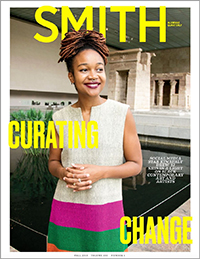Speeches & Media
Neilson’s New Century: Library Renovation Will Build on Tradition and Innovation
Kathleen McCartney, Smith Alumnae Quarterly, Fall 2016
 In the spring, I met with members of the President’s Library Roundtable, a group of alumnae who are advising me on alumnae engagement around the upcoming renovation of Neilson Library, one of the most transformative campus projects in the next decade. During the meeting, I asked the alumnae to share their memories of Neilson.
In the spring, I met with members of the President’s Library Roundtable, a group of alumnae who are advising me on alumnae engagement around the upcoming renovation of Neilson Library, one of the most transformative campus projects in the next decade. During the meeting, I asked the alumnae to share their memories of Neilson.
Several spoke of their lifelong love of reading and how Neilson became their sanctuary. One alumna recounted how Neilson was the place where she went to grapple with the big ideas she had encountered in class. Another said that finally getting her own carrel in her junior year was one of the highlights of her Smith experience. Their stories were poignant and sometimes funny—one alumna confessed that she didn’t step foot in Neilson until her junior year.
Neilson is the intellectual heart of our campus, and its renovation represents a historic moment, a time to create a library reimagined for the 21st century, one that is a compelling resource for our students as well as a destination for scholars and other visitors from around the world who use our special collections.
In October, designer Maya Lin, working in partnership with architectural firm Shepley Bulfinch, will unveil her design for the new Neilson. I promise that you will be inspired and amazed. Her design will reflect the work of our Library Program Committee, led by Provost Katherine Rowe. This committee sponsored 30 focus groups and listening sessions, engaging more than 2,000 students, faculty, staff and alumnae. Four themes emerged: learning, connection, innovation and beauty.
Learning is at the core of an academic library’s mission. The Smith library is used by so many groups of people—students, staff, faculty, visiting scholars, the local community— and our library showcases unique collections, whether on site or shared digitally with scholars around the world. A reimagined Neilson will extend its reach more intentionally to the rest of the campus and to the world.
One of the strongest pieces of feedback we received was students’ desire for more flexible spaces. They envision Neilson as a place for connection, where they can study “alone together”—solo, but not isolated— or pursue group work and team projects. They want places that will inspire moments of reflection and discovery via browsable collections, exhibitions and displays. As a community we want to broaden our perspectives through the people we encounter in Neilson. And we want a café, of course; who can study without coffee?
Neilson is the intellectual heart of our campus, and its renovation represents a historic moment.
The new Neilson will embody innovation, an important theme in Smith’s strategic plan. It will be infused with technology as it balances print and digital resources and supports a culture of experimentation and making. For example, the library complex will encompass the Jill Ker Conway Innovation Center, a state-of-the-art collaborative working space that will foster student and faculty entrepreneurial ventures to address real-world challenges.
Finally, the new Neilson must—and will—be beautiful. Across our community and spanning generations, there is great pride in the beauty of the Smith campus. In keeping with Maya Lin’s passion for landscape and commitment to place, outdoor spaces will be a key part of the design. The flow around the building will be opened up to connect Seelye and Burton lawns and honor the campus’ Olmsted design. The top floor will open up spectacular views of Mount Tom and the surrounding landscape. Sustainability principles will inform the design, in its use of daylight, natural materials and more.
Working with Maya Lin has been a dream. Her passion for the Neilson project is inspired by the role that Smith played in the life of her mother, Julia Chang Lin ’51, who fled Communist China to come to Smith in 1949. Maya loves and values books as well as the possibilities of newer technologies. She is conscious of setting and the way a building resides in context. “As a house of learning and knowledge,” she has said, “the library must...knit together the community and the campus in a way that is respectful of the existing landscape and yet talks to us of our new century.”
As both a renovation and a reimagining, a new Neilson is deeply important to Smith’s mission. Students are eager for the intellectual community and collaboration of a 21st-century library; the faculty is eager for facilities in line with how they teach today. Alumnae are already stepping forward with significant support for the project. In creating its future, Smith has always honored tradition and innovation. I look forward to showing you how we do it this time.